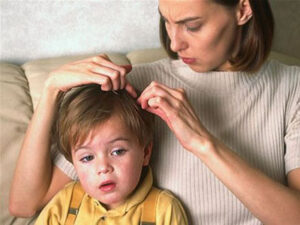SHARE WITH FRIENDS:
Pediculosis (Latin pediculus, “lice”) is an infection of a person with lice, especially common in young children. Lice infestation in children is most common in late summer, early fall, when children return from camp during the summer holidays. It takes several weeks from being infected with lice to the first signs of the disease.
What is a bit?
A lice is a blood-sucking insect that parasitizes the human body up to 4 mm in length. Lice are more common in the warmer part of the head: in the neck area, behind the ears, and in the temples. It is in these places that the bites and bites of lice can be seen. But it’s hard to see the bit itself, they’ll be active. Lice are usually gray in color and can turn dark red when they suck human blood. The female lice live around a month and lay up to five eggs per day.
Bit view
Lice eggs - vinegar can be easily found among the hair. Vinegar is like a transparent ‘bead’, located mainly near the root of the hair. Vinegars ripen in 7-10 days, and young lice emerge from them. It takes 6-10 days for them to lay eggs.
Bit eggs (vinegar)
Vinegar can be easily confused with scab. BUT THEY CANNOT BE STARTED FROM THE BEGINNING.
The lice feed on human blood and pierce the scalp with special suckers (hoses). A bluish-gray mark remains at the site of the bite, and itching occurs under the influence of an enzyme in the saliva of the lice. This enzyme is needed to prevent blood from clotting on the lice. If the wound is severely itchy, a bacterial infection can be added and pus can form. Therefore, it is necessary to identify pediculosis in children in a timely manner.
Bit under a microscope.
Lice are very aggressive, but cannot accumulate energy in the form of fats. Therefore, they are fed frequently. On average once every 2-3 hours. The higher the temperature, the more often it is fed. For lice, a temperature of 15-35 ° C is comfort. At temperatures below 12 ° C they lay eggs and the larvae stop growing.
The most harmful aspect of lice to the organism is their ability to spread epidemic recurrent sweating (typhoid). Typhoid fever in humans is characterized by the passage of its blood into human blood when it is accidentally scratched by a lice infested with typhus.
How to infect lice.
Lice are wingless insects that do not know how to fly, jump, but run fast. Therefore, bit damage can occur through direct contact. In many cases, children can be harmed when playing with pediculosis, when they change their hats, when they lie on a pillow.
Older people can be infected with lice in barbershops, hotels, when using someone’s towel. It is not possible to infect lice from pets. Human lice live and feed only in humans.
